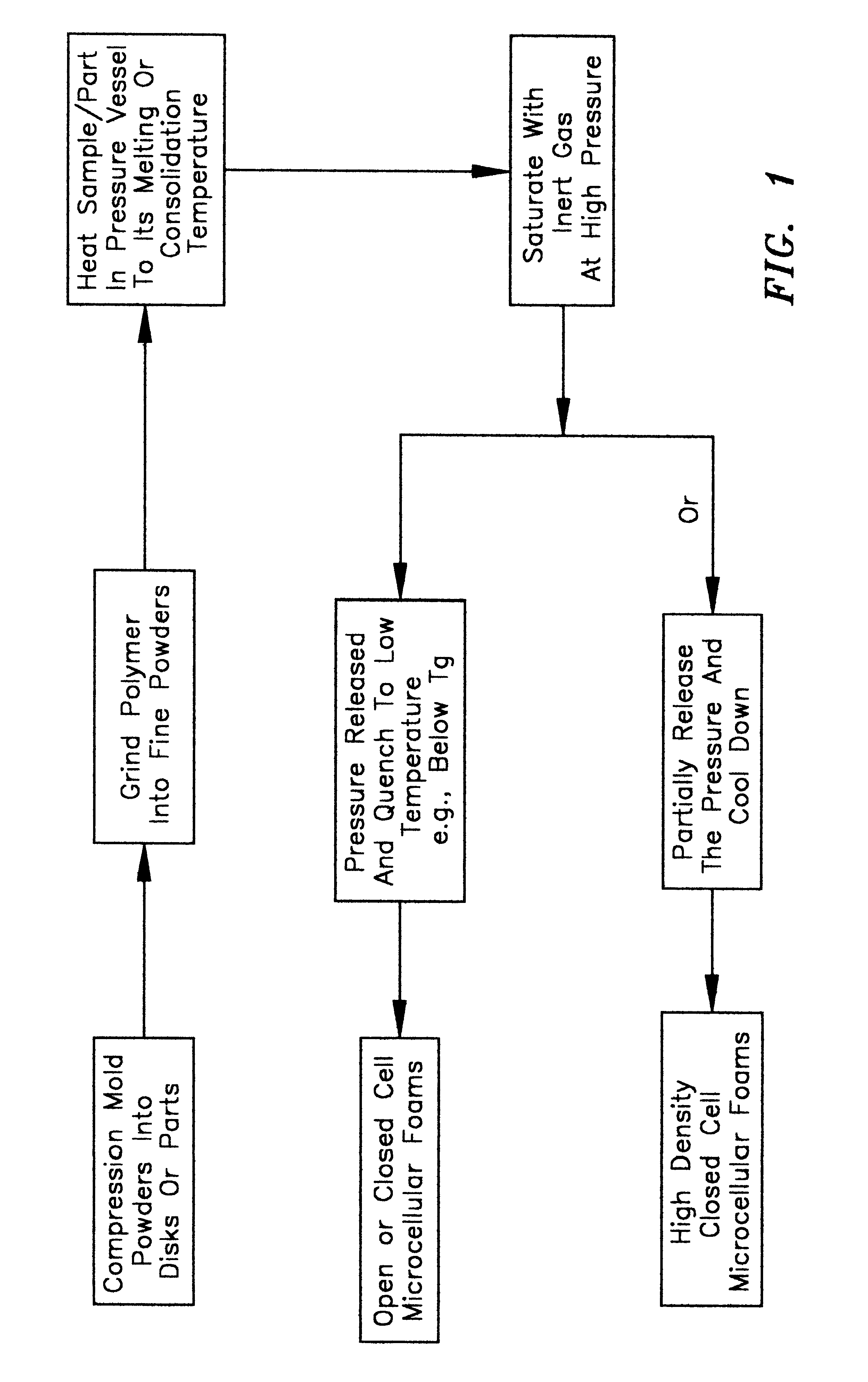Microcellular polymer foams and method for their production
- Summary
- Abstract
- Description
- Claims
- Application Information
AI Technical Summary
Benefits of technology
Problems solved by technology
Method used
Image
Examples
example 1
Samples of Xydar SRT-900, a liquid crystal polymer available for Amoco Chemical Corp. 4500 McGinnis Rd., Alpharettat, Ga. 30202, a powder, were compression molded into a discs 2.26" in diameter and 0.12" at about 1000 psi. Saturation was performed in the same pressure vessel / die combination as consolidation with nitrogen gas at a pressure of 3000 to 4200 psi, a temperature of from about 380 to about 400.degree. C. and for a period for 20 to 50 minutes. Quenching was accomplished by injecting compressed air into the vessel. The resulting foams had the structure shown in the SEM of FIG. 2. After foaming, the samples had expanded to a thickness of 0.42" while the diameter remained essentially the same due to the constraints of the die in which the foaming was performed. The stress-strain capabilities of one of these samples are shown as curve 1 in FIG. 3. Mounting of a sample on an adhesive block followed by polishing with 220 grit sandpaper and diamond based polishing compounds, accor...
example 2
Chopped glass fibers identified as 165A11C obtained from Owens Corning, One Owens Corning Parkway, Toledo, Ohio 43659 were blended with Xydar SRT-900 using a blender. Material blends of approximately 15 and 30% fiber by weight were prepared. The polymer blends were then compression molded in a die as described above to form discs approximately 2.256" in diameter and about 0.15" thick. The glass filled polymer discs were then foamed as described in Example 1 above. One 15% loaded disc swelled to about 0.39", a second 15% loaded disc swelled to 0.40", and the 30% loaded disc swelled to 0.19" after foaming. The structure of samples of 15% loaded material is shown in the SEM of FIG. 5 and a 30% loaded material is shown in FIG. 6.
The compression strain relationships of these materials are shown as samples 2 (15% loaded), 3 also 15% loaded but compression formed twice instead of once as with sample 2, and 4 (30% loaded) in FIG. 3. It should be noted that the reinforcing fibers are aligned...
example 3
Polyphenylene sulfide supplied by Hoechst-Celanese, 90 Morris Ave., Summit, N.J. 07901, as Fortron.RTM. 0205B4 available as a fine powder was compression molded into discs about 2.25" in diameter and 0.16" thick by subjecting them to a pressure of 12,000 psi. Saturation of the compression molded discs was performed at a temperature of from about 300 to about 350.degree. C., and a pressure of 3500 psi for a period of from about 20 to about 40 minutes under a nitrogen atmosphere. The bubble sizes ranged from about 30 to about 120 .mu.m in diameter. The compression load deformation relationship of these materials shows that this material fails at 13.4% average strain while the solid counterparts of this material fails at 3-6%. The compression strength of these foams is 1945 psi, 1190 psi and 824 psi along the x, y, and z axes, respectively.
30% chopped glass loaded samples of Fortron.RTM. were prepared in the same fashion as just described for the unfilled foams, except that glass fiber...
PUM
| Property | Measurement | Unit |
|---|---|---|
| Percent by mass | aaaaa | aaaaa |
| Pressure | aaaaa | aaaaa |
| Pressure | aaaaa | aaaaa |
Abstract
Description
Claims
Application Information
 Login to View More
Login to View More - R&D
- Intellectual Property
- Life Sciences
- Materials
- Tech Scout
- Unparalleled Data Quality
- Higher Quality Content
- 60% Fewer Hallucinations
Browse by: Latest US Patents, China's latest patents, Technical Efficacy Thesaurus, Application Domain, Technology Topic, Popular Technical Reports.
© 2025 PatSnap. All rights reserved.Legal|Privacy policy|Modern Slavery Act Transparency Statement|Sitemap|About US| Contact US: help@patsnap.com

